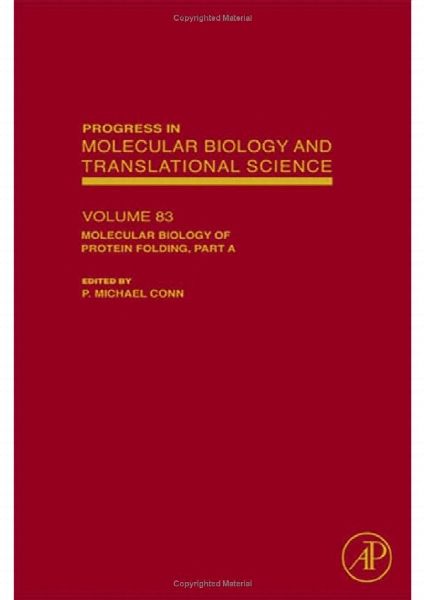Molecular biology of protein folding. Pt. A
- نوع فایل : کتاب
- زبان : انگلیسی
- مؤلف : P Michael Conn
- ناشر : Amsterdam ; Boston : Academic Press
- چاپ و سال / کشور: 2008
- شابک / ISBN : 9780123745941
Description
I. Introduction .................................................................................. 2 A. Structure of the a‐Helix ............................................................... 2 B. Capping Motifs.......................................................................... 4 C. Metal Binding ........................................................................... 4 D. The 310‐Helix ............................................................................ 6 E. The p‐Helix .............................................................................. 6 II. Design of Peptide Helices ................................................................. 7 A. History .................................................................................... 7 B. Host–Guest Studies .................................................................... 8 C. Helix Lengths............................................................................ 8 D. The Helix Dipole ....................................................................... 8 E. Acetylation and Amidation ........................................................... 10 F. Side‐Chain Spacings ................................................................... 10 G. Solubility.................................................................................. 10 H. Concentration Determination ....................................................... 11 I. Design of Peptides to Measure Helix Parameters............................... 12 J. Helix Templates......................................................................... 13 K. Design of 310‐Helices.................................................................. 13 L. Design of p‐Helices .................................................................... 15 III. Helix–Coil Theory........................................................................... 15 A. Zimm–Bragg Model.................................................................... 16 B. Lifson–Roig Model..................................................................... 16 C. The Unfolded State and Polyproline II Helix .................................... 19 D. Single‐Sequence Approximation .................................................... 20 E. N‐ and C‐Caps .......................................................................... 20 F. Capping Boxes .......................................................................... 21 G. Side‐Chain Interactions ............................................................... 21 H. N1, N2, and N3 Preferences......................................................... 21 I. Helix Dipole ............................................................................. 22 J. 310‐ and p‐Helices ...................................................................... 22 K. AGADIR ................................................................................. 23 L. Lomize–Mosberg Model.............................................................. 24 M. Extension of the Zimm–Bragg Model.............................................. 25 N. Tertiary Interactions ................................................................... 25 IV. Forces Affecting a‐Helix Stability........................................................ 25 A. Helix Interior ............................................................................ 25 B. Caps ....................................................................................... 29 C. Phosphorylation......................................................................... 32 D. Noncovalent Side‐Chain Interactions .............................................. 32 Progress in Molecular Biology Copyright 2008, Elsevier Inc. and Translational Science, Vol. 83 1 All rights reserved. DOI: 10.1016/S0079-6603(08)00601-6 0079-6603/08 $35.00 E. Covalent Side‐Chain Interactions................................................... 33 F. Capping Motifs.......................................................................... 33 G. Ionic Strength ........................................................................... 35 H. Enthalpy Change for the Helix–Coil Transition ................................. 36 I. Trifluoroethanol ......................................................................... 37 J. pKa Values................................................................................ 37 K. Relevance to Proteins.................................................................. 38 References .................................................................................... 38
Protein folding has been the underlying etiology in a large number of human diseases and it appears to be a novel method for cellular regulation of the expression of newly translated proteins. This book shows how ubiquitin domain proteins are an ideal model system for experimental and computational studies of protein folding


